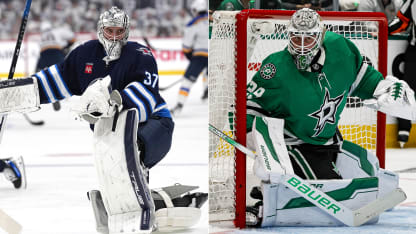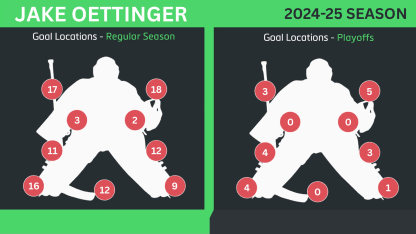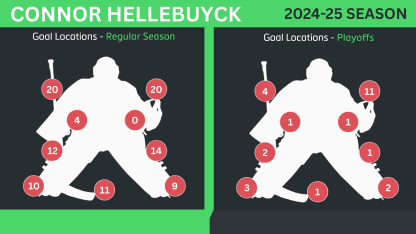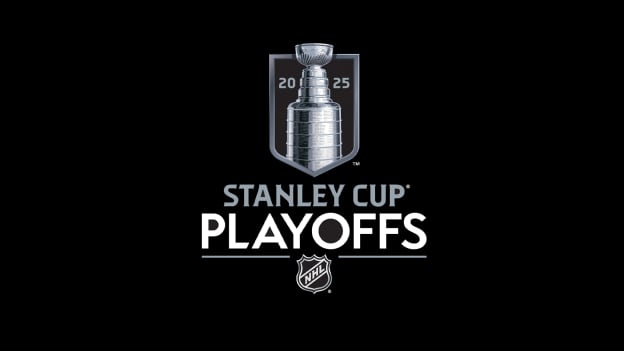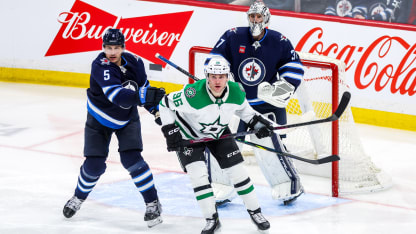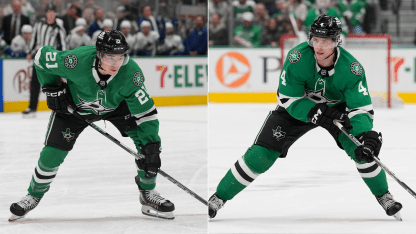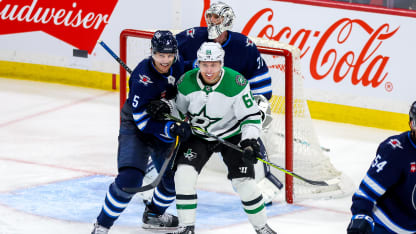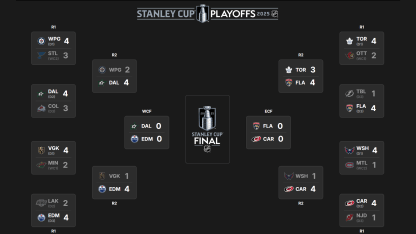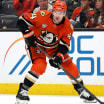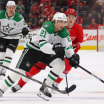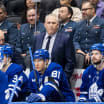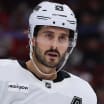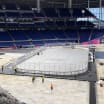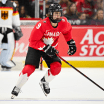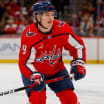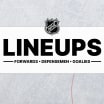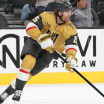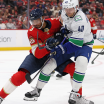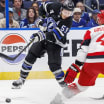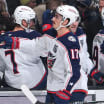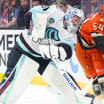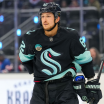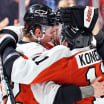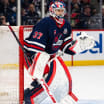Create scrambles from bad angles: Goals scored on shots or passes that bounced off a body or stick in front of the net accounted for 23 percent off the regular season goals and six of 20 in the first round, both well above 14 percent average for the over 8,500 goals tracked for this project since 2017. While the general rule for creating that chaos is to get bodies to the net, Oettinger handles screen shots well, but nine of the 23 broken-play goals he gave up in the regular season originated on sharp-angle attacks from near or below the goal line. There was also a tendency to get a little busy in these scrambles, which accounted for some of the five-hole goals because lateral pushes from the butterfly require a goalie to lift their knee off the ice, and times he got caught outside his posts, opening short-side bank shots or far-side wraparounds.
East-west and quick: Shots after passes and plays that cross the middle of the ice increase the chances of scoring on any goalie, and they accounted for 22 of the tracked goals on Oettinger in the regular season and five of 20 in the first round. While neither number is far off the 22.1 percent average, it’s worth noting how Oettinger plays them, with a tendency to set up wide on plays coming down the wing, which increases the distance he must travel to get across on lateral passes, especially higher in the zone, making it important to get shots off quick and aim at the far side rather than trying to go against the grain back into his late coverage. Oettinger has a somewhat distinct move down into his save stance, lowering his hips and widening his base, which limits mobility for any goalie, so passing after he sets increases scoring odds.
Net drives depend on handedness: Oettinger does a nice job mixing up his net-play coverage with a variety of post-integration techniques that gives shooters different looks, but it is often related to the handedness of the shooter on a net drive below the face-off circle. If he squares up and overlaps his posts on a player on his forehand, he’s got better coverage for a shot, but it takes more of his frame outside of the net and makes it harder to get across on low lateral plays, including wraparounds. If he tucks inside his post using a RVH on a player cutting in on their backhand, he’s in a better position for plays into the middle but sometimes there can be a little space short side over the shoulder or pad on an open shot. Nathan MacKinnon took advantage of this in Game 7 of the first round by driving on the backhand, then after Oettinger dropped into the RVH, he pulled it to his forehand for a quick short-side goal in tight.
Active rebounds: Oettinger only gave up one rebound goal in the first round but there were 13 in the regular season sample, which is only slightly above the tracked average (11.7), but 10 came in just 18 games after the 4 Nations Face-Off, and the total was also above the average last season too. Winnipeg shooters will have to keep in mind that second chances will bounce harder and travel further off Oettinger’s Bauer pads, so being too close doesn’t always help.
Breakaways: One-on-one chances, including off in-zone breakdowns that put a skater in alone, account for 16 goals in the regular season and three in the first round, and while the simple answer would be not to give up so many breakaway chances, it may be worth noting that five of 16 were scored five-hole, and eight came on shots or dekes against the grain.
Connor Hellebuyck
Winnipeg Jets
Hellebuyck is the favorite to win the Vezina Trophy voted as the NHL’s best goalie for the second straight season and third time in his career, but playoff success has been harder to come by for the cerebral 6-foot-4 goalie, who was coming off consecutive first-round exits before advancing in seven games against the St. Louis Blues, and has a save percentage in the .800s for a third straight postseason.
